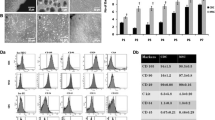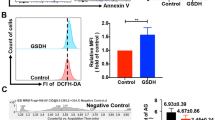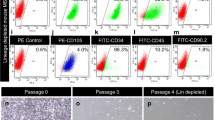Abstract
Mesenchymal stem cells (MSCs) show accelerated regeneration potential when these cells experience hypoxic stress. This “preconditioning” has shown promising results with respect to cardio-protection as it stimulates endogenous mechanisms resulting in multiple cellular responses. The current study was carried out to analyze the effect of hypoxia on the expression of certain growth factors in rat MSCs and cardiomyocytes (CMs). Both cell types were cultured and assessed separately for their responsiveness to hypoxia by an optimized dose of 2,4,-dinitrophenol (DNP). These cells were allowed to propagate under normal condition for either 2 or 24 h and then analyzed for the expression of growth factors by RT-PCR. Variable patterns of expression were observed which indicate that their expression depends on the time of re-oxygenation and extent of hypoxia. To see whether the growth factors released during hypoxia affect the fusion of MSCs with CMs, we performed co-culture studies in normal and conditioned medium. The conditioned medium is defined as the medium in which CMs were grown for re-oxygenation till the specified time period of either 2 or 24 h after hypoxia induction. The results showed that the fusion efficiency of cells was increased when the conditioned medium was used as compared to that in the normal medium. This may be due to the presence of certain growth factors released by the cells under hypoxic condition that promote cell survival and enhance their fusion or regenerating ability. This study would serve as another attempt in designing a therapeutic strategy in which conditioned MSCs can be used for ischemic diseases and provide more specific therapy for cardiac regeneration.








Similar content being viewed by others
Abbreviations
- SCF:
-
Stem cell factor
- TGF-β:
-
Transforming growth factor-β
- VEGF:
-
Vascular endothelial growth factor
- IL-7:
-
Interleukin-7
- HGF:
-
Hepatocyte growth factor
- IGF:
-
Insulin-like growth factor
- MSCs:
-
Mesenchymal stem cells
- CM:
-
Cardiomyocytes
- DNP:
-
2,4-Dinitrophenol
References
Massie BM (2011) Novel targets for the treatment of heart failure: perspectives from a heart failure clinician and trialist. J Mol Cell Cardiol 51:438–440
Wisel S, Khan M, Kuppusamy ML, Mohan IK, Chacko SM, Rivera BK, Sun BC, Hideg K, Kuppusamy P (2009) Pharmacological preconditioning of mesenchymal stem cells with Trimetazidine protects hypoxic cells against oxidative stress and enhances recovery of myocardial function in infarcted heart through Bcl-2 expression. J Pharm Exp Ther 329:543–550
Srivastava D, Ivey KN (2006) Potential of stem-cell-based therapies for heart disease. Nature 441:1097–1099
Kocher AA, Schuster MD, Szabolcs MJ, Takuma S, Burkhoff D, Wang J, Homma S, Edwards NM, Itescu S (2001) Neovascularization of ischemic myocardium by human bone marrow derived angioblasts prevents cardiomyocyte apoptosis, reduces remodeling and improves cardiac function. Nat Med 7:430–436
Orlic D, Kajstura J, Chimenti S, Jakoniuk I, Anderson SM, Li B, Pickel J, McKay R, Nadal-Ginard B, Bodine DM, Leri A, Anversa P (2001) Bone marrow cells regenerate infarcted myocardium. Nature 410:701–705
Brehm M, Zeus T, Strauer BE (2002) Stem cells-clinical application and perspectives. Herz 27:611–620
Ioannidou E (2006) Therapeutic modulation of growth factors and cytokines in regenerative medicine. Curr Pharm Des 12:2397–2408
Ma T, Grayson WL, Frohlich M, Vunjak-Novakovic G (2009) Hypoxia and stem cell-based engineering of mesenchymal tissues. Biotechnol Prog 25:32–42
Takahashi M, Li TS, Suzuki R, Kobayashi T, Ito H, Ikeda Y, Matsuzaki M, Hamano K (2006) Cytokines produced by bone marrow cells can contribute to functional improvement of the infarcted heart by protecting cardiomyocytes from ischemic injury. Am J Physiol Heart Circ Physiol 291:H886–H893
Garin G, Mathews M, Berk BC (2005) Tissue resident bone marrow-derived progenitor cells: key players in hypoxia-induced angiogenesis. Circ Res 97:955–957
Son BR, Marquez-Curtis LA, Kucia M, Wysoczynski M, Turner AR, Ratajczak J, Ratajczak MZ, Janowska-Wieczorek A (2006) Migration of bone marrow and cord blood mesenchymal stem cells in vitro is regulated by stromal-derived factor-1-CXCR4 and hepatocyte growth factor-c-met axes and involves matrix metalloproteinases. Stem Cells 24:1254–1264
Kanellakis P, Slater NJ, Du XJ, Bobik A, Curtis DJ (2006) Granulocytes colony-stimulating factor and stem cell factor improve endogenous repair after myocardial infarction. Cardiovasc Res 70:117–125
Chen Y, Shao JZ, Xiang LX, Dong XJ, Zhang GR (2008) Mesenchymal stem cells: a promising candidate in regenerative medicine. Int J Biol 40:815–820
Sreejit P, Kumar S, Verma RS (2008) An improved protocol for primary culture of cardiomyocyte from neonatal mice. In Vitro Cell Dev Biol Anim 44:45–50
Schneider CA, Rasband WS, Eliceiri KW (2012) NIH Image to ImageJ: 25 years of image analysis. Nat Methods 9:671–675
Jovanović S, Du Q, Sukhodub A, Jovanović A (2009) M-LDH physically associated with sarcolemmal K ATP channels mediates cytoprotection in heart embryonic H9C2 cells. Int J Biochem Cell Biol 41:2295–2301
Crisostomo PR, Wang Y, Markel TA, Wang M, Lahm T, Meldrum DR (2008) Human mesenchymal stem cells stimulated by TNF-alpha, LPS, or hypoxia produce growth factors by an NF kappa B- but not JNK-dependent mechanism. Am J Physiol Cell Physiol 294:C675–C682
Gnecchi M, He H, Noiseux N, Liang OD, Zhang L, Morello F, Mu H, Melo LG, Pratt RE, Ingwall JS, Dzau VJ (2006) Evidence supporting paracrine hypothesis for Akt-modified mesenchymal stem cell-mediated cardiac protection and functional improvement. FASEB J 20:661–669
Kinnaird T, Stabile E, Burnett MS, Shou M, Lee CW, Barr S et al (2004) Local delivery of marrow-derived stromal cells augments collateral perfusion through paracrine mechanisms. Circulation 109:1543–1549
Lee SH, Lee YJ, Song CH, Ahn YK, Han HJ (2010) Role of FAK phosphorylation in hypoxia-induced hMSCS migration: involvement of VEGF as well as MAPKS and eNOS pathways. Am J Physiol Cell Physiol 298:C847–C856
Wang M, Zhang W, Crisostomo P, Markel T, Meldrum KK, Fu XY (2007) STAT3 mediates bone marrow mesenchymal stem cell VEGF production. J Mol Cell Cardiol 42:1009–1015
Brady PA, Zhang S, Lopez JR, Jovanović A, Alekseev AE, Terzic A (1996) Dual effect of glyburide, an antagonist of KATP channels, on metabolic inhibition-induced Ca2+ loading in cardiomyocytes. Eur J Pharmacol 308:343–349
Jovanović A, Jovanović S, Lorenz E, Terzic A (1998) Recombinant cardiac ATP-sensitive K+ channel subunits confer resistance towards chemical hypoxia-reoxygenation injury. Circulation 98:1548–1555
Han J, Kim E, Ho WK, Earm YE (1996) Blockade of the ATP-sensitive potassium channel by taurine in rabbit ventricular myocytes. J Mol Cell Cardiol 28:2043–2050
Haneef K, Naeem N, Iqbal H, Jamall S, Kabir N, Salim A (2010) Gene expression pattern in rat bone marrow mesenchymal stem cells in response to hypoxia. Pak J Biochem Mol Biol 43:90–93
Ishikawa F, Shimazu H, Shultz LD, Fukata M, Nakamura R, Lyons B et al (2006) Purified human hematopoietic stem cells contribute to the generation of cardiomyocytes through cell fusion. FASEB J 20:950–952
Lacza Z, Horvath E, Busija DW (2003) Neural stem cell transplantation in cold lesion: a novel approach for the investigation of brain trauma and repair. Brain Res Protoc 11:145–154
Nygren JM, Jovinge S, Breitbach M, Säwén P, Röll W, Hescheler J, Taneera J, Fleischmann BK, Jacobsen SE (2004) Bone marrow-derived hematopoietic cells generate cardiomyocytes at a low frequency through cell fusion, but not transdifferentiation. Nat Med 10:494–501
Herzog EL, Chai L, Krause DS (2003) Plasticity of marrow-derived stem cells. Blood 102:3483–3493
Jiang Y, Jahagirdar BN, Reinhardt RL, Schwartz RE, Keene CD, Ortiz-Gonzalez XR, Reyes M, Lenvik T, Lund T, Blackstad M, Du J, Aldrich S, Lisberg A, Low WC, Largaespada DA, Verfaillie CM (2002) Pluripotency of mesenchymal stem cells derived from adult marrow. Nature 418:41–49
Nakagami H, Morishita R, Maeda K, Kikuchi Y, Ogihara T, Kaneda Y (2006) Adipose tissue-derived stromal cells as a novel option for regenerative cell therapy. J Atheroscler Throm 13:77–81
Patel AN, Park E, Kuzman M, Benetti F, Silva FJ, Allickson JG (2008) Multipotent menstrual blood stromal stem cells: isolation, characterization, and differentiation. Cell Transpl 17:303–311
Xu J, Liu X, Jiang Y, Chu L, Hao H, Liua Z, Verfaillie C, Zweier J, Gupta K, Liu Z (2008) MAPK/ERK signaling mediates VEGF-induced bone marrow stem cell differentiation into endothelial cell. J Cell Mol Med 12:2395–2406
Cselenyák A, Pankotai E, Horváth EM, Kiss L, Lacza Z (2010) Mesencymal stem cells rescue cardiomyoblasts from cell death in an in vitro ischemia model via direct cell-to-cell connections. BMC Cell Biol. 11:29–38
Xu J, Liu X, Chen J, Zacharek A, Cui X, Savant-Bhonsale S, Chopp M, Liu Z (2010) Cell-cell interaction promotes rat marrow stromal cell differentiation into endothelial cell via activation of TACE/TNFalpha signaling. Cell Transpl 19:43–53
Acknowledgments
The financial support for this study was provided by the Higher Education Commission, Pakistan.
Author information
Authors and Affiliations
Corresponding author
Rights and permissions
About this article
Cite this article
Haneef, K., Naeem, N., Khan, I. et al. Conditioned medium enhances the fusion capability of rat bone marrow mesenchymal stem cells and cardiomyocytes. Mol Biol Rep 41, 3099–3112 (2014). https://doi.org/10.1007/s11033-014-3170-1
Received:
Accepted:
Published:
Issue Date:
DOI: https://doi.org/10.1007/s11033-014-3170-1




